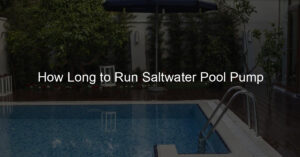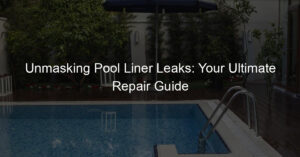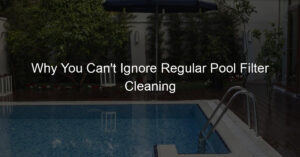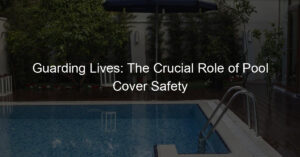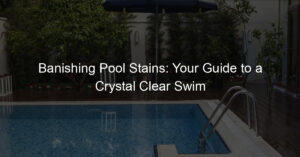Introduction to Pool Chemistry
Pool chemistry might sound like a complex topic, but it’s actually quite simple and very important for maintaining a clean and safe swimming environment. In this section, we will explore the importance of pool chemistry and its key components.
- Understanding the Importance of Pool Chemistry
- Key Components of Pool Water Chemistry
- pH Level: This measures how acidic or basic your pool water is. A pH level of 7.2 to 7.8 is ideal for pools.
- Chlorine Level: Chlorine is a disinfectant that kills bacteria and algae. The ideal chlorine level for pools is 1 to 3 parts per million (ppm).
- Total Alkalinity: This helps to stabilize the pH level in your pool. The ideal total alkalinity level for pools is 80 to 120 ppm.
- Calcium Hardness: This measures the amount of calcium in your pool water. Too much calcium can cause scaling, while too little can cause corrosion. The ideal calcium hardness level for pools is 200 to 400 ppm.
Pool chemistry is all about balance. It’s the science of keeping your pool water clean and safe by maintaining the right levels of various chemicals. Proper pool chemistry ensures that your pool is free from harmful bacteria and algae, which can cause health issues like skin irritation and eye infections. It also helps to prevent damage to your pool equipment and surface.
There are several key components to pool water chemistry. The most important ones include:
Understanding and maintaining these key components of pool chemistry will help to ensure that your pool is clean, safe, and enjoyable for everyone.
Understanding pH Levels in Pool Water
When it comes to maintaining your pool, understanding pH levels is crucial. But what exactly is pH, and how does it affect your pool water? Let’s dive in and find out.
What is pH?
pH is a measure that helps us understand the acidity or alkalinity of a solution. It is measured on a scale from 0 to 14. The middle point, 7, is considered neutral. Anything below 7 is acidic, and anything above 7 is alkaline.
- Definition of pH: pH stands for ‘potential of Hydrogen’. It is a logarithmic scale used to specify the acidity or alkalinity of an aqueous solution. Acidic solutions have a lower pH, while alkaline, or basic, solutions have a higher pH.
- How pH affects pool water: The pH level of your pool water can significantly impact its clarity, safety, and your swimming comfort. If the pH level is too low, it can cause corrosion of pool equipment and irritation to the eyes and skin. On the other hand, if the pH level is too high, it can lead to cloudy water and reduced effectiveness of chlorine, the primary disinfectant used in pools.
Understanding the pH levels in your pool water is the first step towards maintaining a clean, clear, and safe swimming environment. In the next section, we will explore the optimal pH levels for pools and the effects of high and low pH levels.
Understanding Pool pH Levels
When it comes to maintaining a healthy and safe swimming pool, understanding pH levels is crucial. The pH level of your pool water can significantly affect both the water quality and your swimming experience. Let’s delve into the details.
- Optimal pH levels for pools
- Effects of high and low pH levels
The optimal pH level for a swimming pool is typically between 7.2 and 7.8. This range is considered safe for swimmers and also helps to ensure the effectiveness of the chlorine in your pool, which disinfects the water by killing bacteria and other harmful organisms.
High and low pH levels can both have adverse effects on your pool and those who use it. When the pH level is too high, the water can become cloudy, the chlorine becomes less effective, and it can cause skin and eye irritation. On the other hand, a low pH level can corrode metal equipment, cause etching on the surface of the pool, and also lead to skin and eye discomfort.
Understanding and maintaining the right pH level in your pool is not just about keeping the water clear and sparkling. It’s about ensuring the health and safety of everyone who uses the pool. So, make sure to check your pool’s pH level regularly and adjust it as necessary to keep it within the optimal range.
| pH Level | Effects |
|---|---|
| Below 7.2 | Can corrode metal equipment, cause etching on the pool surface, and lead to skin and eye discomfort. |
| 7.2 – 7.8 | Optimal range for pool health and safety. Ensures the effectiveness of chlorine. |
| Above 7.8 | Can cause cloudy water, reduced chlorine effectiveness, and skin and eye irritation. |
Adjusting and Balancing pH Levels in Pools
Understanding how to adjust and balance the pH levels in your pool is crucial to maintaining a safe and enjoyable swimming environment. Let’s explore the steps involved in this process.
- How to Test Pool pH Levels
- Methods to Adjust pH Levels
- Maintaining Balanced pH Levels
Testing the pH levels of your pool is the first step in maintaining a balanced pool. You can use a pool testing kit, which is readily available in most home improvement stores. These kits usually come with a color chart and test strips or liquid drops. To test, simply collect a sample of your pool water, apply the test strip or drops, and compare the resulting color to the chart provided. A balanced pH level is typically between 7.2 and 7.8.
If your pool’s pH level is too high or too low, you’ll need to adjust it. To lower the pH level, you can use a product like sodium bisulfate or muriatic acid. Always follow the manufacturer’s instructions when using these products. If the pH level is too low, you can raise it by adding a product like soda ash or sodium bicarbonate. Remember, adding too much of these chemicals at once can cause the pH level to swing too far in the opposite direction, so it’s best to add them gradually and retest the water after each addition.
Maintaining a balanced pH level in your pool is a continuous process. Regular testing and adjustments are necessary to keep the water safe and comfortable for swimmers. It’s recommended to test your pool’s pH level at least once a week. Also, keep in mind that factors like heavy rainfall, the number of swimmers, and the temperature can affect the pH level. Regularly monitoring and adjusting as needed will ensure a balanced and healthy pool.
Understanding and managing the pH levels in your pool is an essential part of pool maintenance. By regularly testing and adjusting the pH levels, you can ensure a safe and enjoyable swimming experience for everyone.
Understanding Chlorine Levels in Pool Water
Let’s dive into the world of pool chemistry, specifically focusing on chlorine. This chemical plays a crucial role in keeping our swimming pools clean and safe. But what exactly is chlorine? And how does it work?
What is Chlorine?
Chlorine is a chemical element that is often used in the form of a compound to sanitize water. It’s a powerful disinfectant that is commonly used in swimming pools to kill bacteria and other harmful microorganisms.
- Role of chlorine in pool water
- How chlorine works to sanitize pool water
Chlorine’s main job in pool water is to act as a disinfectant. It helps to kill bacteria, viruses, and algae that can make swimmers sick. Without chlorine, pool water would quickly become a breeding ground for these harmful microorganisms.
Chlorine works to sanitize pool water through a process called oxidation. When chlorine is added to pool water, it breaks down into various chemicals, including hypochlorous acid (HOCl) and hypochlorite ion (OCl-). These chemicals kill microorganisms and bacteria by attacking the lipids in their cell walls and destroying their enzymes and structures inside the cell. This process effectively neutralizes the threat they pose to swimmers’ health.
In conclusion, chlorine is a vital component in maintaining a clean and safe swimming pool. It’s important to understand how it works and its role in pool water to effectively manage and maintain your pool’s chemistry.
Understanding Chlorine Levels in Pools
Chlorine is a vital component in maintaining a clean and healthy swimming pool. It’s crucial to understand the optimal levels of chlorine in your pool and the effects of having too much or too little. Let’s dive into these topics.
- Optimal Chlorine Levels for Pools
- Effects of High and Low Chlorine Levels
The ideal chlorine level for most swimming pools is between 1.0 and 3.0 parts per million (ppm). This range ensures that the pool is safe for swimming while effectively killing bacteria and other harmful microorganisms. Keeping the chlorine level within this range is a key aspect of pool maintenance.
Both high and low chlorine levels can have adverse effects. If the chlorine level is too high, it can cause skin and eye irritation and may even damage pool equipment. On the other hand, a low chlorine level may not effectively kill bacteria and other harmful microorganisms, leading to cloudy water and potential health risks.
Remember, maintaining the right chlorine level in your pool is a balancing act. Regular testing and adjustment are necessary to ensure a safe and enjoyable swimming environment. In the next section, we will discuss how to adjust and balance chlorine levels in pools.
| Chlorine Level | Effects |
|---|---|
| Below 1.0 ppm | May not effectively kill bacteria and other harmful microorganisms, leading to cloudy water and potential health risks. |
| 1.0 – 3.0 ppm | Ideal range for most swimming pools. It ensures that the pool is safe for swimming while effectively killing bacteria and other harmful microorganisms. |
| Above 3.0 ppm | Can cause skin and eye irritation and may even damage pool equipment. |
Adjusting and Balancing Chlorine Levels in Pools
Keeping your pool’s chlorine levels in check is crucial for maintaining a clean and safe swimming environment. Let’s explore how to test, adjust, and balance these levels effectively.
- How to Test Pool Chlorine Levels
- Fill the testing vial with pool water.
- Add the appropriate number of testing drops or tablets, as indicated by the kit’s instructions.
- Shake the vial gently to mix the solution.
- Compare the color of the solution to the color chart provided with the kit. This will give you the chlorine level of your pool.
- Methods to Adjust Chlorine Levels
- Lowering Chlorine Levels: If the chlorine levels are too high, you can lower them by simply letting the pool sit under the sun. Sunlight naturally breaks down chlorine. Alternatively, you can add a chlorine neutralizer.
- Raising Chlorine Levels: If the chlorine levels are too low, you can raise them by adding more chlorine. Be sure to follow the manufacturer’s instructions to avoid over-chlorination.
- Maintaining Balanced Chlorine Levels
- Test your pool’s chlorine levels regularly, at least once a week.
- Adjust the chlorine levels as needed, following the methods outlined above.
- Keep in mind that factors like the number of swimmers, sunlight exposure, and water temperature can affect chlorine levels.
Testing your pool’s chlorine levels is a straightforward process. You will need a pool testing kit, which you can purchase from a pool supply store. Here’s a simple step-by-step guide:
If your pool’s chlorine levels are too high or too low, you’ll need to adjust them. Here’s how:
Maintaining balanced chlorine levels is key to ensuring a safe and clean pool. Here are some tips:
Remember, maintaining the right balance of chlorine in your pool is not just about keeping the water clear and sparkling. It’s also about ensuring the health and safety of everyone who uses the pool. So, make it a habit to regularly test and adjust your pool’s chlorine levels.
Mastering the Balance between pH and Chlorine
One of the most important aspects of maintaining a swimming pool is understanding and managing the balance between pH and chlorine levels. Let’s dive into this topic to learn more about it.
- Understanding the relationship between pH and chlorine
The pH level of your pool water directly affects the efficiency of the chlorine. pH is a measure of how acidic or basic the water is. The scale ranges from 0 to 14, with 7 being neutral. Pool water should ideally have a pH between 7.2 and 7.6.
When the pH level is too high, the chlorine becomes less effective at killing bacteria and algae. On the other hand, if the pH level is too low, the chlorine will be overly active, leading to potential skin and eye irritation for swimmers.
Therefore, it’s crucial to maintain a balanced pH level to ensure the chlorine can do its job properly.
- How to achieve a perfect pH and chlorine balance
Achieving the perfect balance between pH and chlorine levels in your pool is a matter of regular testing and adjustment. Here are some steps you can follow:
- Test the water: Use a pool testing kit to check the pH and chlorine levels at least once a week.
- Adjust the pH: If the pH is too high, you can use a pH reducer. If it’s too low, a pH increaser is needed. Always follow the instructions on the product label.
- Adjust the chlorine: If the chlorine level is too low, add more. If it’s too high, you may need to dilute the pool water.
- Retest and repeat: After making adjustments, give the chemicals time to circulate in the pool, then retest the water. Repeat the process until the balance is right.
Remember, maintaining a balanced pH and chlorine level in your pool is not a one-time task, but an ongoing responsibility. With regular testing and adjustments, you can ensure a safe and enjoyable swimming experience for everyone.
| Parameter | Ideal Level |
|---|---|
| pH | 7.2 – 7.6 |
| Chlorine | 1 – 3 ppm |
In conclusion, mastering the balance between pH and chlorine is essential for maintaining a healthy and clean pool. By understanding their relationship and how to adjust them, you can ensure your pool is always ready for a swim.
Understanding Pool Maintenance
Keeping a pool clean and safe for swimming involves a series of regular maintenance tasks. These tasks are essential to ensure the longevity of your pool and the health of those who use it. Let’s delve into the specifics of these tasks.
Regular Pool Maintenance Tasks
Regular pool maintenance can be broken down into three primary tasks:
- Testing Water Chemistry
- Cleaning and Skimming
- Filter Maintenance
Testing the water chemistry is the first step in pool maintenance. This involves checking the pH and chlorine levels in your pool. The pH level should be between 7.2 and 7.8, while the chlorine level should be between 1.0 and 3.0 parts per million. Regular testing will help you maintain the right balance and ensure the water is safe for swimming.
Cleaning and skimming your pool is another crucial task. This involves removing debris from the water and cleaning the pool walls and floor. Skimming should be done daily, while thorough cleaning can be done once a week. This will keep your pool looking clean and inviting.
The last task is filter maintenance. The pool filter plays a vital role in keeping the water clean by removing dirt and debris. It’s important to clean your filter regularly and replace it when necessary. A well-maintained filter will improve the efficiency of your pool and prolong its lifespan.
In conclusion, regular pool maintenance is essential for the health and safety of your pool. By performing these tasks regularly, you can enjoy a clean and safe swimming environment all year round.
Seasonal Pool Maintenance
Proper pool maintenance doesn’t stop with regular cleaning and water chemistry checks. It also involves seasonal preparations. Let’s dive into two key seasonal tasks: preparing your pool for summer and winterizing your pool.
- Preparing Your Pool for Summer
As the warm season approaches, it’s time to get your pool ready for all the fun summer activities. Here are some steps to follow:
- Remove the Pool Cover: Start by removing and cleaning the pool cover. It’s important to ensure it’s dry before storing to prevent mold and mildew.
- Clean the Pool: Next, clean the pool thoroughly. This includes skimming, vacuuming, and brushing the pool walls and floor.
- Check the Water Level: Refill the pool to the appropriate level, typically halfway up the skimmer opening.
- Test and Adjust the Water Chemistry: After refilling the pool, test the water chemistry. Adjust the pH, chlorine, and other chemical levels as necessary.
- Winterizing Your Pool
As summer fades into fall, it’s time to prepare your pool for the colder months. Here’s how to winterize your pool:
- Balance the Water Chemistry: Before closing the pool, balance the water chemistry. This helps protect the pool from damage during winter.
- Lower the Water Level: Lower the water level to below the skimmer line. This prevents freezing water from damaging the pool’s plumbing system.
- Clean and Cover the Pool: Clean the pool thoroughly and cover it. The cover protects the pool from debris and harsh weather conditions.
Remember, seasonal pool maintenance is crucial for keeping your pool in top shape year-round. By preparing your pool for summer and winterizing it properly, you can ensure it’s ready for use when the warm weather returns and protected during the cold months.
Case Study: Pool Chemical Balance
Let’s dive into a real-world example to understand the importance of maintaining the right pool chemical balance. This case study will provide a practical understanding of the consequences of unbalanced pool chemistry and the steps taken to correct it.
- Real-world example of a pool with unbalanced chemistry
- Steps taken to correct the imbalance
- Results and key takeaways
Consider a community swimming pool in a small town. The pool was popular and heavily used during the summer months. However, the pool maintenance was not up to the mark. The pH levels were consistently high, and the chlorine levels were low. The result? The water turned cloudy, and the pool walls developed algae. Swimmers complained of skin and eye irritation. The pool had to be closed for several days, disappointing the community.
The pool management decided to take action. They hired a professional pool maintenance service. The professionals first tested the water to understand the exact chemical imbalance. The pH level was 8.2, way above the ideal range of 7.2 to 7.8. The chlorine level was less than 1 ppm, which is lower than the recommended 1-3 ppm. The professionals then added muriatic acid to lower the pH and shock treatment to increase the chlorine levels. They also scrubbed the pool walls to remove the algae.
After the treatment, the pool water became clear, and the algae disappeared. The pH and chlorine levels were back within the ideal range. The swimmers were happy, and the pool was back in action. The pool management learned a valuable lesson about the importance of regular pool maintenance and the right chemical balance.
Remember, maintaining the right pool chemistry is not just about clear water or preventing algae. It’s about the health and safety of the swimmers. Regular testing and adjustment of pool chemicals can prevent such issues and ensure a safe and enjoyable swimming experience.
Conclusion: The Importance of Mastering Pool Chemistry
As we reach the end of our journey into the world of pool chemistry, it’s important to reflect on the key points we’ve covered. Understanding and mastering pool chemistry is not just about keeping your pool looking clean and inviting, it’s about ensuring the health and safety of those who use it.
- Recap of the importance of pH and chlorine balance
Remember, the balance of pH and chlorine in your pool water is crucial. The pH level, which measures how acidic or basic the water is, should ideally be kept between 7.2 and 7.8. This range ensures that the chlorine in the water can effectively kill bacteria and other harmful organisms, keeping your pool safe for swimming.
Chlorine levels, on the other hand, need to be maintained between 1.0 and 3.0 parts per million. This level of chlorine is enough to sanitize the water, but not so much that it irritates swimmers’ skin and eyes. Achieving the right balance between pH and chlorine levels can seem tricky, but with regular testing and adjustment, it becomes a manageable task.
- Final thoughts on pool maintenance
Pool maintenance is more than just balancing chemicals. It involves regular cleaning, checking the pool’s filtration system, and monitoring the water level. However, understanding and mastering pool chemistry is a significant part of this process.
By keeping a close eye on your pool’s pH and chlorine levels, and making adjustments as necessary, you can ensure a safe, healthy, and enjoyable swimming environment for everyone. Remember, a well-maintained pool is a happy pool!
So, as we conclude, remember that mastering pool chemistry is not just a chore or a task, it’s a responsibility. It’s about ensuring that your pool is a safe, clean, and enjoyable place for everyone who uses it. And with the knowledge you’ve gained from this guide, you’re well on your way to becoming a master of pool chemistry!



